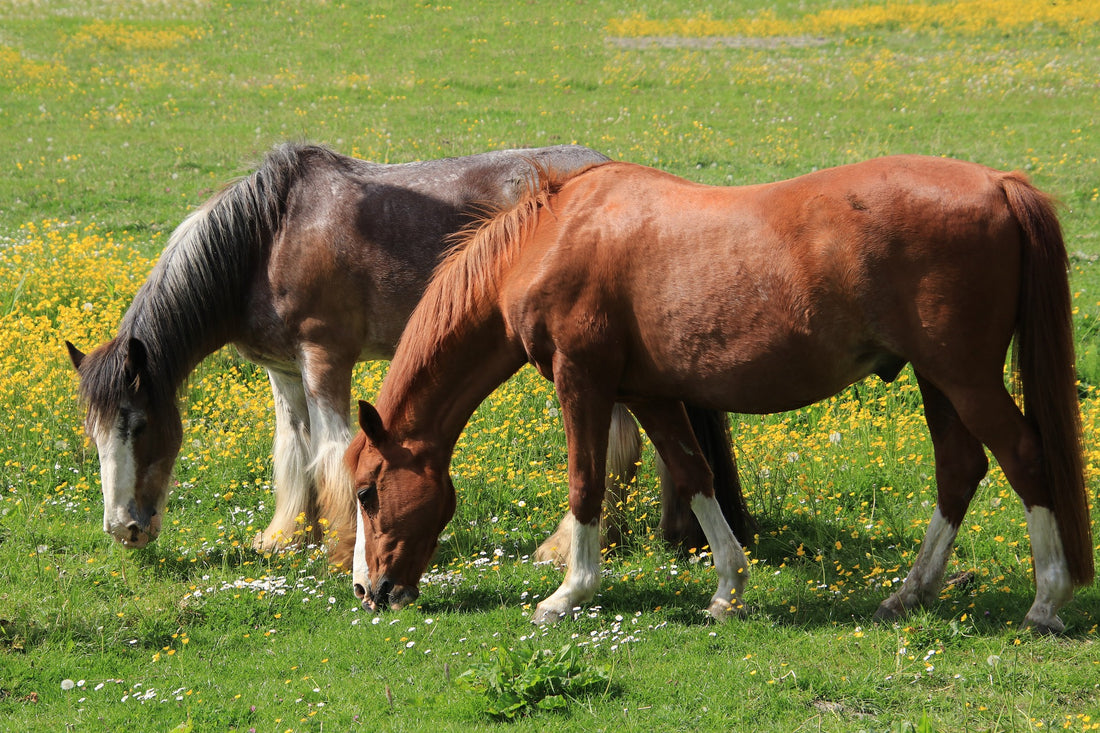Spring Routine Changes

Written by Briony Witherow MSc, BSc, RNutr.
With spring just around the corner, this month’s blog focuses on supporting the digestive tract as we change our management and feeding routines over the coming weeks.
During April and March we tend to see an increase in grass growth which, when coupled with an increase in turnout time for many, can result in digestive challenge. In this situation, the gut is faced with both a change in forage type and management. So why is this such a problem and what can we do to help our horses cope?
The Problem
There is nothing nicer for many of us than to see our horses back out on pasture and the prospect of less mucking out and haynet filling is always a happy one. While some horse owners may not have any choice over the timeline of management changes, if you do, ensuring a gradual reintroduction to pasture (over a few weeks) can be hugely beneficial.
While both hay, haylage and grass are essentially the same ingredient - grass; the nutrient content and amount of moisture (water) they contain is very different. Lower fibre levels in fresh grass coupled with a higher water content is what causes the most obvious digestive issue evident in spring: very loose and green manure. For example, a 500kg horse fed 10kg of hay would consume 1.5 litres of water and the reimaining 8.5kg as nutrients (dry matter) and a horse eating 10kg of fresh grass would consume 8.5 litres of water and only 1.5kg of nutrients, put this way, it is easy to see how the digestive system might struggle with such a change.

Figure 1: Typical Moisture and Dry Matter Content of Common Forages
Helping our horses cope with the change.
For very sensitive horses and owners that have full autonomy over their horse’s turnout, if you can make the change in routine (increasing pasture time and decreasing hay/haylage) over 2-4 weeks, that is ideal. Where this is not possible, practices such as offering hay/haylage in the field or bringing your horse in for a few hours a day for hay/haylage will help to increase fibre and dry matter intake which will help to support gut function. Remember the golden rule of feeding: make all changes gradually and try to only make one change at a time. You can monitor how your horse is coping by keeping an eye on manure.
Remember that even spring grass lacks essential vitamins and minerals.
While grass typically contains enough energy and protein to meet a horse’s requirements, it is often lacking in micronutrients (in particular minerals like zinc and copper). As a minimum be sure to provide a broad spectrum vitamin and mineral supplement (like Selenavite E) to ensure a balanced diet.
Digestive Support
Proactive provision of a digestive supplement introduced ahead of any changes, and fed to span the transition in management/diet is advisable, particularly for those with sensitive guts.
Digestive supplements are typically based around improving the environment or population of microbes that reside in the horse’s hindgut. The horse depends on this population of microbes to be able to digest and utilise nutrients from the forage portion of his diet. These microbes become accustomed to breaking down specific feedstuffs, as such, when the diet changes, the microbe population must shift to reflect this. Research suggests that this adaptation can take as long as 3 to 4 weeks (depending on how large the difference is between diets). If change occurs too quickly, microbes struggle to cope, resulting in digestive upsets. Where the microbe population is compromised, your horse’s ability to digest fibre is reduced.
Pre and probiotics are commonly referred to as digestive enhancers. Probiotics like Transvite Excel contain live yeast – these are best fed short term during or after any event which may disturb the hindgut’s bacterial population. Providing a probiotic will help to repopulate the hindgut with beneficial fibre digesting microbes.
Many products contain a combination of both pre and probiotics such as Transvite Gut Balancer. Prebiotics help to multiply existing useful bacteria and can help to support the microbial population during changes in feed and management. Where probiotic only products are generally recommended for shorter term use, prebiotics or combined pre and probiotic products can be fed for longer periods of time and are a useful addition to all feed rooms.
Take Home Points
- Make changes gradually, even the reintroduction of turnout where possible.
- If you can’t make changes gradually, provide additional support with a digestive supplement and try and boost fibre (and dry matter) intake where possible by providing hay/haylage out in the field or in the stable if you can bring the horse in for a few hours per day.
- Keep an eye on how your horse is coping with the changes by monitoring manure for any changes.
